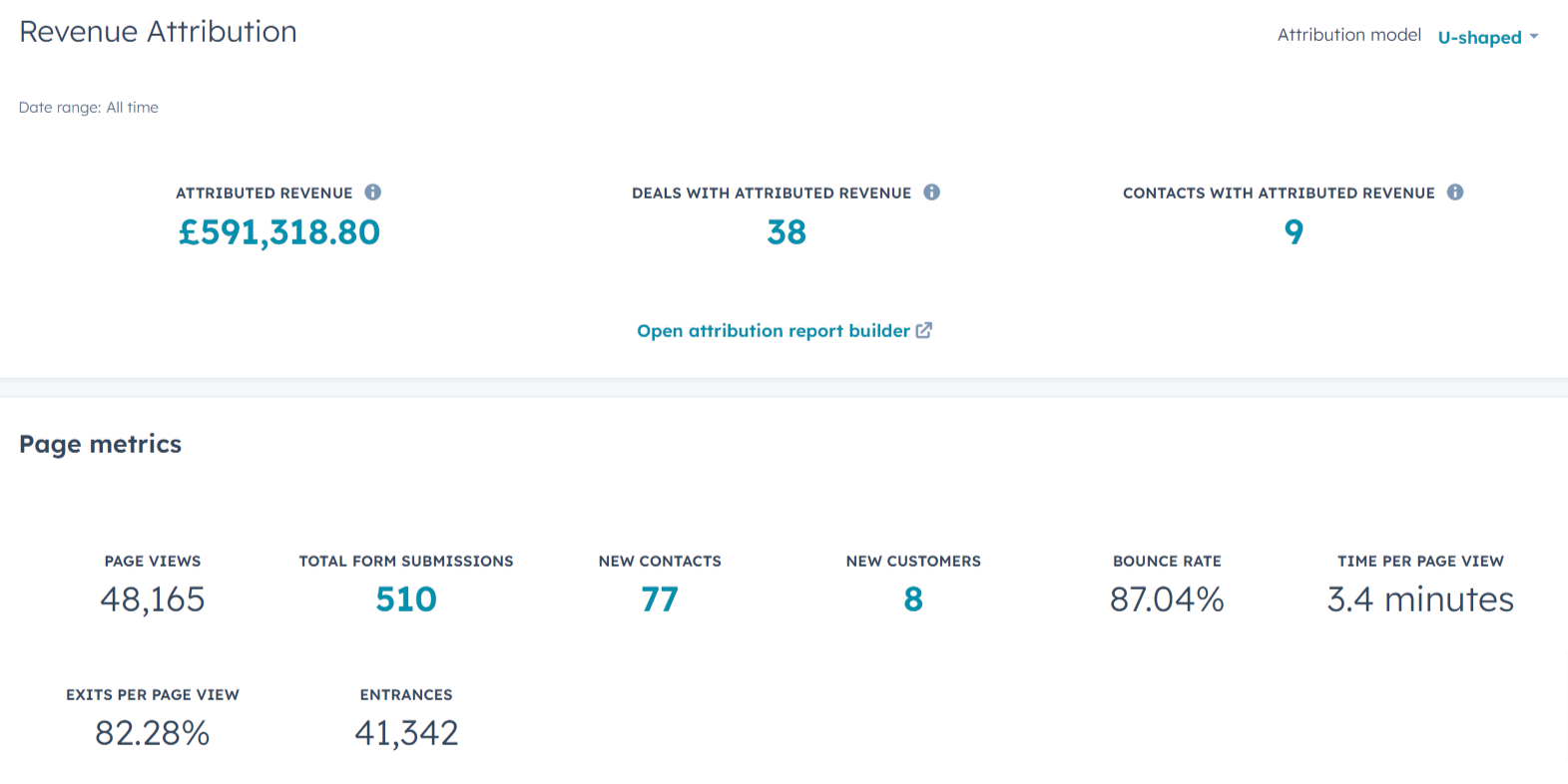B2B Content Marketing: How Much Does It Cost Per Month & How Can The Cost Be Reduced?
Are you a B2B company struggling to determine the right amount of content to produce each month, while also trying to reduce costs? Do you want to know how to reduce the costs associated with content production?
After helping B2B companies grow with the help of content marketing for more than 12 years, and having written articles that generated hundreds of thousands of dollars in attributed revenue, I know what it takes to grow your organic traffic, generate hundreds of new leads a month, and increase revenue through content.
In this article, we will cover how much other B2B companies usually spend on content every month and what factors to consider when determining the optimal amount of content for your organization. We will look at an example content plan, what to expect as an outcome, and what the associated costs would look like. Finally, we will explore two effective ways on how to reduce those costs.
Too Long, Didn't Read
- Companies typically spend $30,000+ per month on content creation, optimization, and management.
- The amount of content needed depends on the goal you are trying to achieve and the speed with which you need to reach said goal.
- An example content plan for a mid-size B2B company ($21,500 per month): 12 blog posts, 1 educational resource asset, 1 customer story/case study, 1 pillar page, 12 LinkedIn posts, 4 short-form videos, 2 website/YouTube videos, 1 nurture sequence, and 1 newsletter
- Bringing your content marketing in house to achieve that plan will require two full-time content managers and one videographer which results in $15,000 in monthly salaries.
- Generative AI will make your internal content managers 20-30% more efficient over the next 12-18 months, freeing up additional bandwidth.
How Much Do Companies Spend On Content Per Month?
According to the HubSpot 2022 State of Media & Content Planning Report, almost half (49%) of marketing teams allocate between 30% and 50% of their entire marketing budget to content. In extreme cases, 5% spend more than 70%, and 4% only spend 1-10% of their budget on content.
In terms of dollars and cents, the same study reveals that 38% of marketers spend between $40,000 and $100,000 per quarter on content, while 16% allocate between $100,001-$200,000 per quarter. Only 17% budgeted for less than $40,000. However, 8% of the respondents spent more than $300,000 per quarter.
In other words, companies commonly budget $30,000+ per month for content creation, optimization, and management. This does not include paid media or other types of marketing.
How Much Content You Need Depends On Your Goals
A very common question is: How much content do we actually need? Well, you might have guessed the answer: It depends on your goals and how fast you need to get there.
Primary Goal: Organic Traffic
If you are relatively new to content marketing or have done content marketing unsuccessfully in the past, your first goal might be to have more visitors come to your website.
This used to be a common goal by itself, but now it is often tied into a more holistic strategy like demand or lead generation. But if this is your goal, and you are just starting, shoot for a minimum of three blog posts a week and one content cluster/pillar page a month.
Primary Goal: Brand Awareness & Demand Generation
A lot of B2B companies are focusing their efforts at the moment on brand awareness and demand generation, creating content for the sake of creating content so it can be promoted on social media and used in paid social ads and search advertisements.
While I firmly believe that if you answer your buyer's questions in the best and most helpful way possible and focus on becoming the trusted voice in your space, you don't need to worry about brand awareness and demand generation, I understand that some organizations choose that strategy.
In terms of content, you will focus a lot on campaignable, top-of-the-funnel assets, like blog posts, webinars, social posts, etc.
Primary Goal: Lead Generation
If your primary goal is lead generation, have a look at the example table below to get you started. With a downloadable lead-gen asset, like an eBook, whitepaper, or guide per month in addition to a case study and a pillar page, you have a good mix to start with. Be sure to plan your assets to cover all stages of the funnel and align them with your primary buyer persona for maximum effect.
Primary Goal: Sales Enablement
If you have decent organic traffic and you are generating some leads through your website, our recommendation almost always is to start here. This might sound counterintuitive, but this gets you maximum return-on-investment for your content marketing as you roll up the problem from the back.
Instead of waiting for top-of-the-funnel organic traffic to build up and then nurturing them through the to-be-built funnel, you create content first for buyers in the later stages of the buyer's journey, e.g., versus and comparison articles, cost and ROI calculators, and so on. This way, sales can use the content for selling and prospecting AND you work on organic traffic and lead gen.
What Content Quality Are We Talking About?
Before we go into how much it all costs, let's talk about quality. My goal as a They Ask, You Answer coach is always to get the organizations that I am working with to become THE Voice of Trust in their space. You don't get there by putting out regurgitated mediocre content!
The content I am talking about stands head and shoulders above the content that is already out there. This is mainly due to three reasons:
- We tackle the questions buyers are desperate to get answers to but other businesses are unwilling to answer (e.g., pricing, best of, comparisons, etc.)
- Rather than writing a fluffy blog post summarizing what has already been said, this content is based on interviews with internal subject matter experts who have years of experience and deep expertise.
- Therefore, the content is better researched, more helpful, and offers greater insights than already existing content.
This is all hard work which requires a significant investment. Now this is all good, but how do you measure the quality of a piece of content to make sure you are getting a return on your investment?
The answer is simple: You track the direct impact it has on your revenue. Below is a screenshot of how a single blog post I wrote for a client has performed so far. It generated 77 new contacts, 8 new customers, and around $755,000 in attributed revenue.

While not every blog post will be like this, creating the best quality content increases your chances drastically. So, if even 1% of the blog posts you create performs like this, your ROI is just over 900% considering the listed investments below.
Our Recommendation For A Medium-Size B2B Company
We recommend that a mid-size B2B company looking to generate about 5-7 new customers (or 500 new leads) every month in the next six to twelve months should, at a minimum, create 35 different pieces of new content a month. Here is why: Only 1% of website visits turn into a lead, so you will need to receive about 50,000 website views monthly.
To reach this level of lead generation, you need to not only consistently create and publish great content, but also ensure that the content is highly targeted to your buyer persona's research behavior and focuses entirely on answering their questions, addressing their concerns, worries, and fears, and helping them progress in their purchasing decision.
Example: Monthly Content Plan For Mid-Size B2B Company With Cost (Lead Generation)
Below is an example of what this could look like (based on what most B2B companies would start with based on the current level of content maturity):
| Content Type | Pieces per Month | Cost per Piece | Total Cost per Month |
| Blog posts (3+ per week, high-quality, 1,200-1,600 words) | 12 | $750 | $9,000 |
| Educational lead magnet, whitepaper, or other downloads incl. conversion path, CTAs, email | 1 | $2,500 | $2,500 |
| Customer story or case study incl. conversion path, CTAs, email | 1 | $2,000 | $2,000 |
| Pillar Page (incl. CTA) | 1 | $2,000 | $2,000 |
| LinkedIn Posts (3 per week) | 12 | $100 | $1,200 |
| Short-form video for LinkedIn and other social channels (Self-shot) | 4 | $200 | $800 |
| Website/YouTube videos (Videographer) | 2 | $1,500 | $3,000 |
| Nurture Sequence (6 emails) | 1 | $500 | $500 |
| Newsletter | 1 | $500 | $500 |
| Total | 35 | $21,500 |
Keep in mind that this is only an example. Depending on the specific target audience the company is trying to attract, the industry they operate in, their current level of brand awareness, their content marketing maturity, and many other factors, the exact content distribution could change. For example, this could also include other content creation tasks such as:
- Monthly Webinar,
- Bi-Weekly Podcast,
- Quarterly Thoughtleader Roundtable Event,
- Weekly LinkedIn Newsletter,
- Infographics,
- Quizzes,
- Calculators,
- Assessments,
- and much more.
Before we move on to how you can reduce this monthly investment, let's talk about the big ticket items: blog posts, downloadable assets, case studies, pillar pages, and website/YouTube videos.
3+ Big 5 Articles/Blog Posts Per Week
When it comes to publishing blog posts, finding the right balance of quantity and quality is key. While some companies like HubSpot or ImpactPlus may opt for daily blog posts, research suggests that publishing 2 to 4 high-quality articles per week (preferably Big 5 articles) tends to yield the best results for most B2B organizations.
Of course, the exact number of blog posts you should publish will depend on your specific goals, target audience, and content marketing strategy. Check out this article to learn more about what goes into the cost of a blog post.
1 Educational Resource, Lead Generation, Or Sales Enablement Asset Per Month
These downloadable resources (usually 2,000-3,000 words) can include anything from your traditional lead generation offer (e.g., checklist, guide, eBook, or whitepaper) to sales enablement content, such as buyer's guides, business case templates, and more. You can either repurpose blog or other content, or write an entirely new one.
I included in the cost for each resource the research, writing, editing, and producing of the asset into PDF format, as well as the conversion path including the landing page, thank you page, CTAs, and promo and follow-up emails.
1 Success Story Or Case Study Per Month
Customer success stories and case studies (usually 1,500-2,000 words) are well-designed website pages or downloadable PDF documents. The cost here includes the internal and customer interviews, the writing, editing, and producing of the case study, a promo email, and CTAs. Ideally, this would be paired with a customer journey video (see videos).
1 Pillar Page Per Month
Pillar pages allow you to organize your blog content and other resources in a logical and concise fashion to create a one-shop resource for your buyers. Think of the pillar page as the high-level summary that puts everything into context, and the single articles as deep-dives into smaller sub-topics. This could be an "Ultimate Guide" type pillar page or a resource page. All related blog posts should point to the pillar page, and the pillar page should point to the blog posts. To minimize your effort and cost involved, ensure that you strategically plan your pillar pages with the article content calendar.
2 Website/YouTube Videos Per Month
96% of marketers see video as an "important part" of their marketing strategy, according to HubSpot. While we recommend that our They Ask, You Answer Mastery clients aim for 10 website/YouTube videos per quarter, I included two videos a month in the example above because video creation can be very expensive ($1,500-$3,000 per video on average) if done externally.
The type of video you are looking for here isn't your animated explainer video. Instead, you want customer journey videos, bio videos for each executive and salesperson, pricing and landing page videos, etc. This requires a videographer to come to a location, set up and break down equipment, and film for a half to a full day.
In summary, having a downloadable resource, a case study, a pillar page, and two videos gives you five CTAs/campaigns per month you can promote on social media, add to your newsletter, integrate into your sales sequences, utilize in assignment selling, and more.
How Can I Reduce The Cost Of The Content I Need?
At this point, you might be thinking, "Wow, I understand the need for content, but is there a way to reduce the monthly cost?" There are two ways you can do that while also improving the quality of your content at the same time:
- Bring your content marketing in house by hiring a content manager (and videographer).
- Embrace generative AI to increase the efficiency of your content team.
Hiring An In-House Content Manager
Some of the best candidates for this job that we have seen are recent journalism graduates. The average salary of a content manager is around $60,000 - $67,000 in the United States, although it varies somewhat by region. Let's say that this will run you $5,500 a month in a fully loaded salary.
With some training, a new content manager can comfortably produce 3+ high-quality blog articles per week after three to six months. After that, they can start to add the creation of pillar pages, lead-gen assets, and other content onto their roster.
For the example above, you might need to have two full-time content managers that are also responsible for creating the copy for the LinkedIn posts, newsletters, and emails. Or you can have one full-time content manager writing the blog articles, the pillar page, and the written assets for lead gen etc., while a marketing manager takes care of social media, conversion paths, and email marketing. In any case, as your writers get more efficient over time, and with the help of AI, you should have more capacity to add a few more content pieces.
A full-time videographer should be able to film, edit, and publish 10 website/YouTube videos a quarter. In the example above, I only accounted for 2 videos a month, so hiring an in-house videographer should allow you to publish 3-4 videos a month. The salary of a videographer is around $48,000 in the United States, so the monthly fully loaded costs are about $4,000.
In total, having two content managers and one videographer on staff will cost you $15,000 a month, resulting in significant savings:
- 2 Content Managers (FTE): $11,000
- 1 Videographer (FTE): $ $4,000
Increase Content Marketing Efficiencies With Artificial Intelligence (AI)
Another way you can reduce the costs of your content marketing is by making your writers more efficient. Generative AI can help you increase the efficiency and productivity of your content team without compromising the quality of your content.
By using AI tools such as natural language processing (NLP) and machine learning (ML), you can automate time-consuming tasks like initial research, topic ideation, assisting with writing and editing, and writing meta descriptions. You can use it to generate summaries of webinars or videos, create social media messages, and personalized emails.
With generative AI, you can produce more high-quality content in less time and at a lower cost, giving you a competitive edge in your industry. In fact, according to Paul Roetzer, the head of the AI Marketing Institute, generative AI will make knowledge workers 20-30% more efficient over the next 12-18 months.
Conclusion: B2B Companies Spend An Average Of $15,000 (Internal) and $30,000 (Agency Model) On Content Marketing A Month
B2B companies typically spend between 30-50% of their entire marketing budget or $30,000 per month for content creation, optimization, and management. When bringing your content marketing in house, you can not only reduce that monthly investment by almost half, but also improve the quality of the content you are creating as you are fully in control of the process. In addition, generative AI will make your writers more efficient.
Share this
You May Also Like
These Related Stories
![How Much Does A Blog Post Cost? [1,000 Words, High-Quality, B2B, Agency vs. Freelancer]](https://blog.3pcreativegroup.com/hubfs/How%20Much%20Does%20A%20Blog%20Post%20Cost%20%5B1%2c000%20Words%2c%20High-Quality%2c%20B2B%2c%20Agency%20vs.%20Freelancer%5D%20%281%29.jpg)
How Much Does A Blog Post Cost? [1,000 Words, High-Quality, B2B, Agency vs. Freelancer]
![Marketing Agency vs. In-House Marketing + Coaching [A Side-By-Side Cost Comparison]](https://blog.3pcreativegroup.com/hubfs/Marketing%20Agency%20vs.%20In-House%20Marketing%20+%20Coaching%20%5BA%20Side-By-Side%20Cost%20Comparison%5D.png)
How Much Does It Cost To Hire A Marketing Agency vs. Doing Your Own Marketing (Incl. Coaching)?

.png?width=250&height=125&name=TrustBuilderLogoWhiteTranspBackgr(250x125%20px).png)




No Comments Yet
Let us know what you think